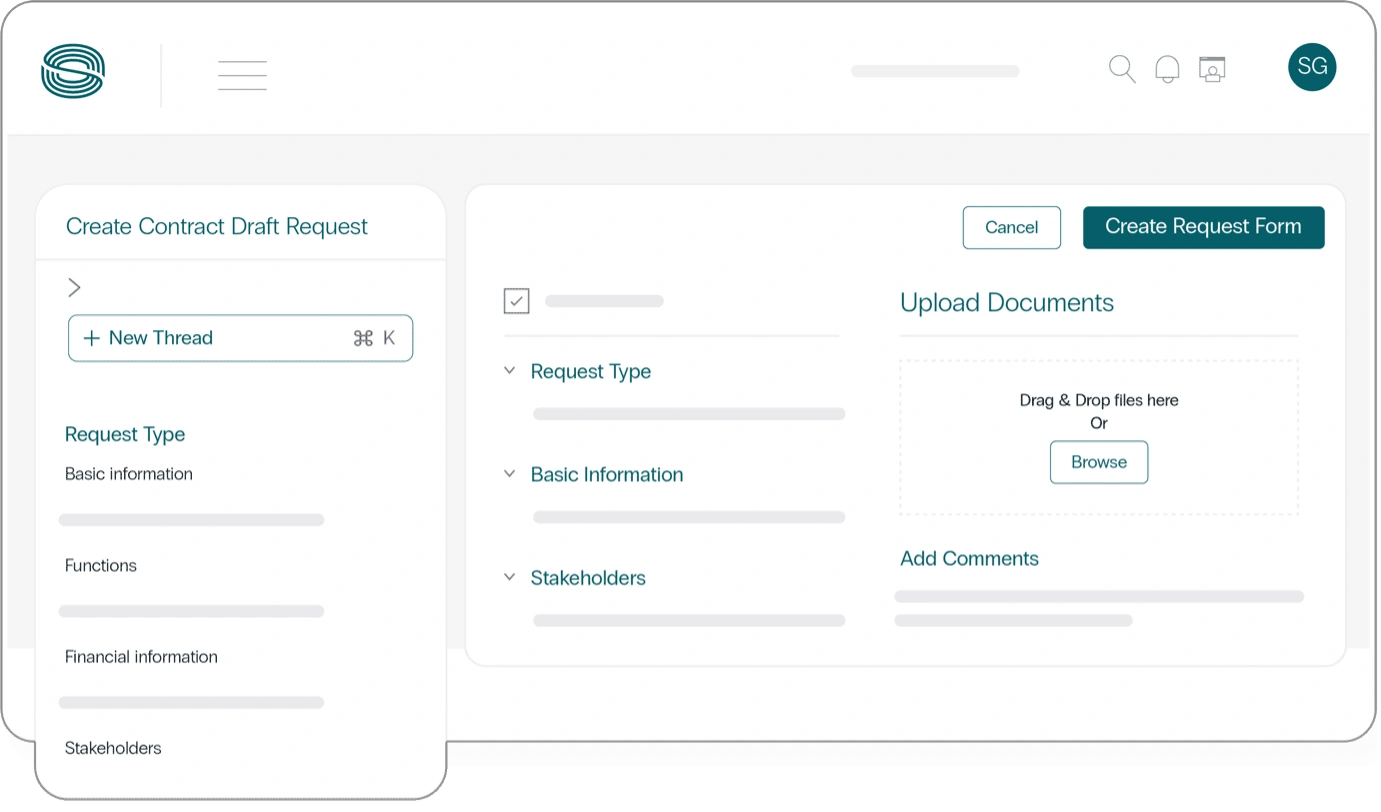
- Last Updated: Dec 11, 2025
- 15 min read
- Arpita Chakravorty
Contracts govern everything from vendor relationships and revenue recognition to regulatory compliance and intellectual property. “Yet, the process of creating contracts—especially at scale—can be error-prone, time-consuming, and inconsistent without proper systems in place.
What is Contract Creation?
Contract creation is the process of drafting a legally binding agreement that accurately captures the rights, responsibilities, and obligations of the involved parties. It involves selecting the correct contract type, defining terms, setting deliverables and timelines, and ensuring compliance with legal and commercial standards.
Key Stages of the Contract Creation Process:
- Selecting the right contract type (e.g., NDA, MSA, SOW, supplier contract)
- Drafting using templates or manual inputs
- Incorporating approved clauses and fallback positions
- Internal collaboration and stakeholder reviews
- Final legal vetting and approval
While the contract creation process involves inputs from various departments, the legal team plays a critical role in setting the guardrails that make contracts enforceable, compliant, and consistent.
Legal’s Role in the Contract Creation Process
While multiple stakeholders—from procurement and sales to finance—contribute to contract creation, the legal team plays a pivotal role in shaping the contract’s structure and safeguarding the organization from risk. Their involvement ensures that every contract drafted is not only clear and enforceable, but also aligned with legal, regulatory, and strategic business standards.
Here’s how legal teams contribute at each step:
- Template Governance: They develop and maintain standardized contract templates and clause libraries, ensuring consistency and reducing manual drafting errors.
- Risk Assessment: Legal evaluates potential risks, flags non-standard terms, and proposes fallbacks to protect the organization’s interests.
- Compliance Checks: From data privacy and employment laws to sector-specific regulations, legal teams ensure every clause aligns with the applicable legal framework.
- Negotiation Guidance: During contract redlining and counterparty collaboration, legal provides strategic input to balance risk and commercial value.
- Final Review & Approval: No contract is finalized without legal sign-off, serving as the last line of defense before execution.
By integrating closely with business functions and leveraging CLM tools, legal teams help accelerate contract turnaround while maintaining control and compliance.
Even with a well-defined process and legal oversight, organizations face persistent hurdles that can slow down or complicate contract creation.
Common Challenges in Contract Creation
Despite being foundational to business, many organizations still rely on fragmented, manual contract creation processes. Let’s explore the most common challenges that make this stage a bottleneck.
- Manual drafting of frequently used clauses, increasing turnaround time
- Inconsistent language and risk exposure across contracts from different departments
- Over-reliance on legal teams, even for low-risk agreements
- Compliance risks due to outdated clauses or missing fallback positions
- Lack of visibility into past negotiations and clause usage patterns
These issues not only delay contract finalization but also create downstream problems in negotiation, compliance, and renewals.
Contract Creation Process: Streamlined with Templates and Playbooks
Templates provide a reliable structure for contracts, incorporating approved language and essential clauses that can be tailored for each transaction. Meanwhile, playbooks offer a roadmap for
contract negotiations, outlining terms, fallback positions, and acceptable variations, ensuring consistency without reinventing the wheel for each contract.
Here’s how you can use these tools to streamline the entire contract creation process, making it faster, clearer, and more consistent across your organization:
Craft Effective Contract Templates for Quick Turnaround
Contract Templates streamline creation process by providing a pre-approved structure that teams can use repeatedly. Key strategies for effective templates include:
- Define Core Terms and Clauses: Identify and standardize essential clauses, such as payment terms, liability, confidentiality, and intellectual property.
- Tailor for Transaction Types: Use more comprehensive templates for high-risk, high-value contracts, while routine agreements can have simpler, ready-to-sign formats.
- Simplify with Standard Language: Using approved language across templates ensures consistency and limits the need for extensive legal review, enabling teams to customize only what’s unique to each deal.
Develop Contract Playbooks for Clear Negotiation Guidelines
Contract playbooks provide clear instructions on handling specific terms and outline fallback positions in case of negotiation. They support consistency and efficiency by:
- Outlining Acceptable and Non-Negotiable Terms: Detail the boundaries for negotiable clauses, specifying what terms can be adjusted and which are non-negotiable.
- Documenting Common Scenarios and Responses: Record typical negotiation patterns, such as frequent objections or typical customer requests, so teams know when to stand firm or offer adjustments.
- Establishing a ‘Walk Away’ Position: Specify deal-breaking terms to prevent unnecessary time spent negotiating unfavourable terms.
Re-evaluate Templates and Playbooks Regularly for Continued Relevance
Over time, even the most well-structured templates and playbooks can become outdated. Regularly revisiting and updating them is essential for maintaining alignment with business needs:
- Review for Industry Changes: Update templates and playbooks in response to regulatory updates or changes in market standards.
- Eliminate Unnecessary Terms: Simplify documents by removing redundant or outdated terms that no longer add value.
- Improve Readability: Ensure language is accessible and clear to avoid unnecessary back-and-forth, reducing confusion and speeding up approvals.
Reduce Bottlenecks by Defining Team Roles
Many contract delays stem from unclear responsibilities in the contract creation process. Streamline this by assigning roles upfront:
- Identify Essential Reviewers: Determine who needs to be involved at each stage, ensuring legal and procurement only review high-stakes agreements.
- Empower Non-Legal Teams: Use playbooks and templates to guide non-legal teams in drafting routine agreements, freeing up legal resources for more complex matters.
While templates and playbooks provide the framework, AI-powered CLM Platforms like Sirion take contract creation to the next level—automating routine steps, guiding users with smart insights, and ensuring consistent compliance.
Streamline Playbooks and Templates with Sirion’s Contract Creation Tools
AI is a transformative force in contract management, especially when it comes to building and managing playbooks, clause libraries, and template libraries. Sirion’s AI-driven capabilities enable you to create and negotiate contracts more efficiently through self-service contract generation, smart guidance, and automated workflows, ensuring the right stakeholders are involved at the right time.

Build and Manage Playbooks, Clause Libraries, and Templates
Sirion’s AI helps streamline playbook and template setup by:
- Automatically Extracting and Classifying Clauses: AI-powered NLP can analyze existing contracts to suggest standardized clauses and organize them into a central library.
- Dynamic Playbook Creation: AI analyzes past negotiations to identify frequently used terms and fallback positions.
- Self-Serve Contract Generation: Non-legal teams, such as sales or procurement, can leverage AI-driven templates and playbooks to generate contracts independently. This “self-serve” model speeds up routine contracts and ensures adherence to pre-approved terms without involving Legal in every step
Sirion’s AI helps you set up templates and playbooks faster. But even with the right technology in place, it’s important to follow best practices to ensure long-term consistency and governance.
Contract Creation Governance: Best Practices for Managing Clauses and Templates
Even with the right tools in place, governance is key. To maintain consistency, reduce risk, and scale contract operations effectively, follow these foundational practices:
- Version Control: Maintain audit trails of changes made to templates or clauses, so teams always work with the most recent and approved content
- Approval Workflows: Set defined approval paths for updates to legal language, ensuring cross-functional alignment
- Metadata Tagging: Use tags (e.g., region, contract type, risk level) to make clauses and templates easily searchable
- Usage Monitoring: Analyze how often templates are used and where deviations occur, feeding insights back into template refinement
- Centralized Ownership:Assign owners for different template categories (e.g., NDAs, MSAs, SOWs) to ensure accountability and alignment
So how exactly does AI enable smarter, faster, and more consistent contract creation? Let’s take a closer look.
How AI Powers Smarter Contract Creation
AI doesn’t just speed up contract creation—it transforms how contracts are assembled, reviewed, and approved by learning from historical data and applying smart logic.
Here’s how AI works behind the scenes:
- Natural Language Processing (NLP): Extracts, classifies, and standardizes clauses from legacy contracts
- Machine Learning: Identifies commonly used fallback positions, negotiation trends, and deviation risks
- Smart Recommendations: Suggests preferred clause language based on contract type, jurisdiction, and counterparty
- Predictive Routing: Determines which contracts can follow a fully automated route and which need legal intervention
- Real-Time Risk Flagging: Flags deviations from playbooks, triggering alerts and reviews
These AI functions allow teams to move from reactive contract handling to proactive, insight-driven contract management.
Automate Contract Creation Workflows with AI-Driven Routing and Alerts
AI can configure workflows for different types of contracts, ensuring the contract creation process is smooth and tailored to each contract’s complexity:
- Automate Simple Contracts: For low-risk, routine agreements, AI can automate the entire creation process—generating the initial draft, applying standard clauses, and routing it for e-signature upon completion.
- Route Complex Contracts: For high-value or high-risk agreements, AI intelligently routes the contract to relevant stakeholders, triggering alerts for required approvals or revisions. This prevents bottlenecks and ensures that contracts receive attention from the appropriate teams.
- Smart Alerts and Compliance Triggers: With workflow automation, AI can also trigger compliance alerts if the contract deviates from approved playbook terms, notifying teams of required reviews or necessary approvals to maintain compliance standards.
Manual vs. AI-Powered Contract Creation: A Quick Comparison
| Feature | Manual Contract Creation | AI-Powered Contract Creation |
|---|---|---|
| Drafting Speed | Time-consuming and repetitive | Fast and automated |
| Clause Consistency | Varies across departments | Standardized from clause library |
| Legal Team Dependency | Required for most agreements | Only needed for complex contracts |
| Compliance Risk | Higher due to human oversight | Lower with automated risk detection |
| Review Workload | High workload for Legal | Reduced through guided playbooks |
| Insights and Reporting | Limited | Rich analytics and clause usage insights |
With AI in place, contract generation shifts from a legal bottleneck to a strategic enabler of business agility.
Final Thoughts: Accelerate Your Contract Generation Process with AI Insights
Templates and playbooks lay the groundwork for scalable contract operations. But with AI-driven CLM Platforms, you can automate the entire lifecycle—from generation and negotiation to compliance—enabling legal and business teams to focus on strategic outcomes instead of repetitive admin.
Frequently Asked Questions (FAQs) on Contract Creation
How does contract creation differ from contract authoring?
Can I automate contract creation with CLM software?
Yes, modern CLM (Contract Lifecycle Management) software allows you to automate contract creation using pre-approved templates, clause libraries, and rule-based workflows. This reduces manual drafting, ensures consistency across agreements, and accelerates turnaround times—especially for high-volume or low-risk contracts. Advanced CLM tools also enable dynamic contract assembly based on contract type, jurisdiction, or business function.
What kinds of contracts benefit most from automated creation tools?
High-volume, low-risk contracts like NDAs, sales orders, MSAs, and vendor agreements benefit most from automation. These contracts often follow repeatable patterns and can be templatized, reducing the need for legal review in every instance.
What’s the difference between static contract templates and dynamic contract templates in CLM systems?
Static templates are fixed documents that users fill in manually. Dynamic templates, used in AI-enabled CLM tools, allow for conditional logic, clause substitution based on risk profiles or contract type, and auto-population of data—making them far more flexible and scalable.
Is contract creation software only useful for legal teams?
No. Modern contract creation tools are built for cross-functional use. Sales, procurement, finance, HR, and operations teams can use predefined templates and playbooks to initiate contracts independently while ensuring legal and compliance safeguards remain intact.
How does improved contract creation impact downstream stages like negotiation and compliance?
A well-structured contract generation process ensures standardized clauses, fewer errors, and predefined fallback positions. This leads to faster negotiations, reduced friction, and more reliable audit trails—improving both compliance and post-signature obligation tracking.
Can contract generation systems integrate with CRM or procurement tools?
Yes. Most enterprise-grade CLM systems integrate seamlessly with tools like Salesforce, SAP Ariba, Oracle, and Microsoft Dynamics. This allows for automatic population of contract data, workflow triggers, and syncing of metadata across platforms.
What should organizations consider before investing in contract creation software?
Key factors include the volume and complexity of contracts, the current bottlenecks in the process, integration needs with existing systems, regulatory requirements, and the readiness of internal teams to adopt structured workflows.
Additional Resources

Contract Clause Library: What it is and Why You Need One

